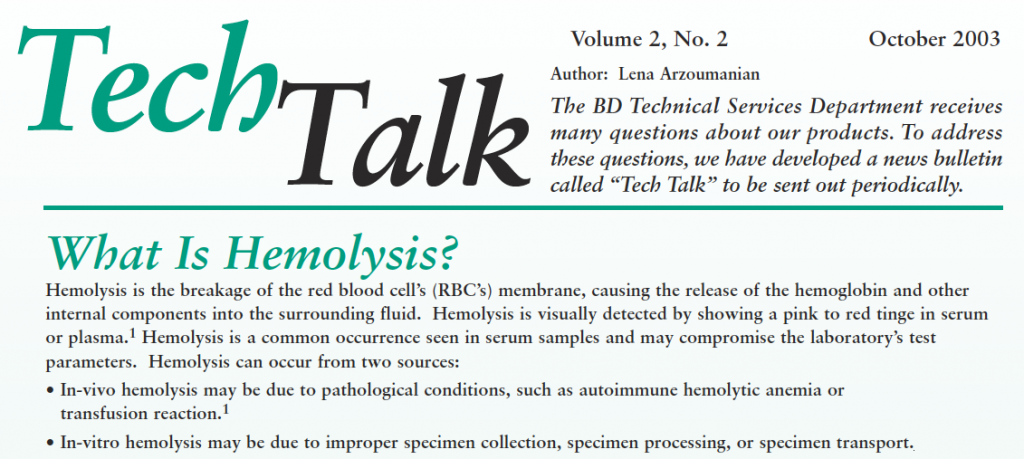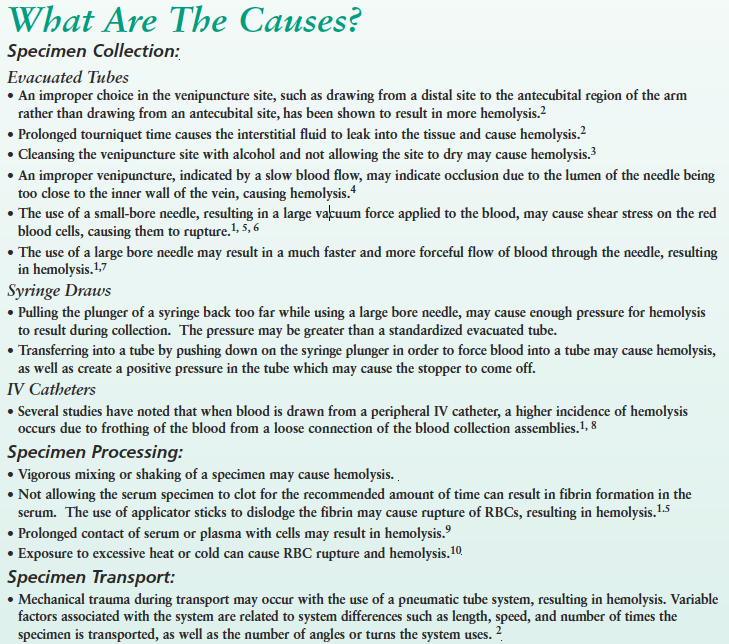Hemolysis is a particular problem in the proper quantification of EtOH in a blood sample.
First let’s define what it is:

What does it look like?

Red blood cells without (left and middle) and with (right) hemolysis. If as little as 0.5% of the red blood cells are hemolyzed, the released hemoglobin will cause the serum or plasma to appear pale red or cherry red in color. Note that the hemolyzed sample is transparent, because there are no cells to scatter light.

If there is hemolysis, it can be gross and very noticeable as it produces a light pink hue to the blood instead of the customary red blown that we have all seen as it is taken from the arm or it can be slight. Most failures in life and in processes are not typically gross in nature.
When running headspace gas chromatography with flame ionization detector (HS-GC-FID), hemolysis will always produce a higher BAC result than if there was no hemolysis. It has to do not so much with the sample but rather the technique of sample introduction meaning the headspace technique itself.
Using the headspace technique, we are not directly sampling the blood (the liquid phase) but instead the headspace above the liquid phase (the gaseous phase). As such, it is subject and dependent to the principles of Henry’s Law. Henry’s Law states that at equilibrium at a constant pressure, temperature and flow in a closed system, the amount in the headspace is proportional to the amount liquid phase. It is static and predictable at equilibrium. This relationship is called the partition ratio or K.
For example, based upon empirical and valid research we know that the partition ratio of ethanol in a true aqueous (water) sample at 50 degrees is 1220:1.
Some folks mistake the concept of partition ratio. A partition ratio can be thought of as the measurement of resistance of the volatile organic compound to elute (escape) to the gaseous phase. The higher the partition ratio the more resistance. The higher the partition ratio (K), the more resistance there is for the VOC to escape into the gaseous phase and therefore there will be less VOC present in the gaseous phase to examine.
What effects partition ratio are a few factors including but not limited to Beta which for our purposes can be simplified to the matrix that the liquid phase is. In short, the more stuff in the matrix, the higher the partition ratio because there is more “stuff” that the VOC has to travel through to escape the gaseous phase. In inverse is also true. The less stuff, in the matrix, the lower the partition ratio because there is less “stuff” that the VOC has to interact with and travel through to escape to the gaseous phase.
So, in incorporating the above we arrive at the following conclusions:
- The lowest partition ratio possible is in the case of aqueous matrix that contains EtOH.
- The highest partition possible is if the EtOH is a matrix with a lot of “stuff” (think blood).
Therefore, between the two, the higher EtOH concentration reported will be in the one that is closest to the one that is most aqueous like as the partition ratio lowest in the aqueous matrix.
Hemolysis or the red blood cell burstis will change the partition ratio to be closer to that of an aqueous sample. The result is lower partition ratio and more EtOH in the headspace and more EtOH reported.
So if you had two aliquots from the same homogenized blood sample and therefore would objectively have the same EtOH in aliquot one and aliquot 2, but before you analyzed them you took aliquot 2 and hemolyzed the sample, the hemolyzed aliquot 2 would report a higher BAC than that of aliquot 1. If there was direct liquid injection, then we would expect they would actually have the same BAC reported.


